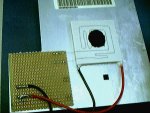It is all about assumptions really. Assuming any measuring device absorbs 100% of incoming radiation is a big step, but not unreasonable unless you have information that proves otherwise.
My idea with the whole concept of using resistors as heating sources was to build something with about 10% accuracy. If you want to go further than that 10%, there are many problems to consider, even the accuracy of your voltage meter if you want to go towards 1% or so.
I still believe a 10% accurate power meter is a valuable asset to anyone experimenting with lasers though... especially since it will show a more-pwer-reads-more-response for tuning systems, regardless of actual accuracy.
Times ago, i tried something similar with a 40x40mm TEC (i was not sure if i had this thing around, so i searched before post) ..... the thin wire glued (with superglue

) on the upper plate is constantane wire, that i had around ..... i used a piece of exactly 10 ohm, and used it as "thermal calibration element" ..... the reading from the thermal calibration was working good enough, but the too big plate was not good for the laser reading ..... it was needing too much time for thermal stabilization, and also not working good under 100mW, so i abandoned the idea ..... maybe reaching to do something similar with a 10x10, or 6x6 TEC. it can work better .....
But, basically, that what i meant is, the item that you use for "paint black" the absorption zone, influence a lot the reading ..... when i made these tests, calibrating it for 200mW, then reading from different known lasers (200mW IR, 120mW blue, 180mW red, 115mW green, all measured with a calibrated instrument), i had very variable readings, changing also around 35-40%, from color to color, using different "black coatings", also if the thermal calibration reading was always the same ..... so, that what i meant was, yes, the system is good for calibration, but only if we find a reliable and efficent black coating, with an absorption index that is almost flat, from IR to UV .....
Maybe I'm just awesome? I used a glass cutter and scored both sides of a 40mm x 40mm tec, pressed on the seam and snap - it broke right in half. Soldered a wire to the last junction in the series and it was up and working.
You was very lucky ..... or you have a career in the glass industry, the one that you prefer from the two







